Physical Address
304 North Cardinal St.
Dorchester Center, MA 02124
Physical Address
304 North Cardinal St.
Dorchester Center, MA 02124
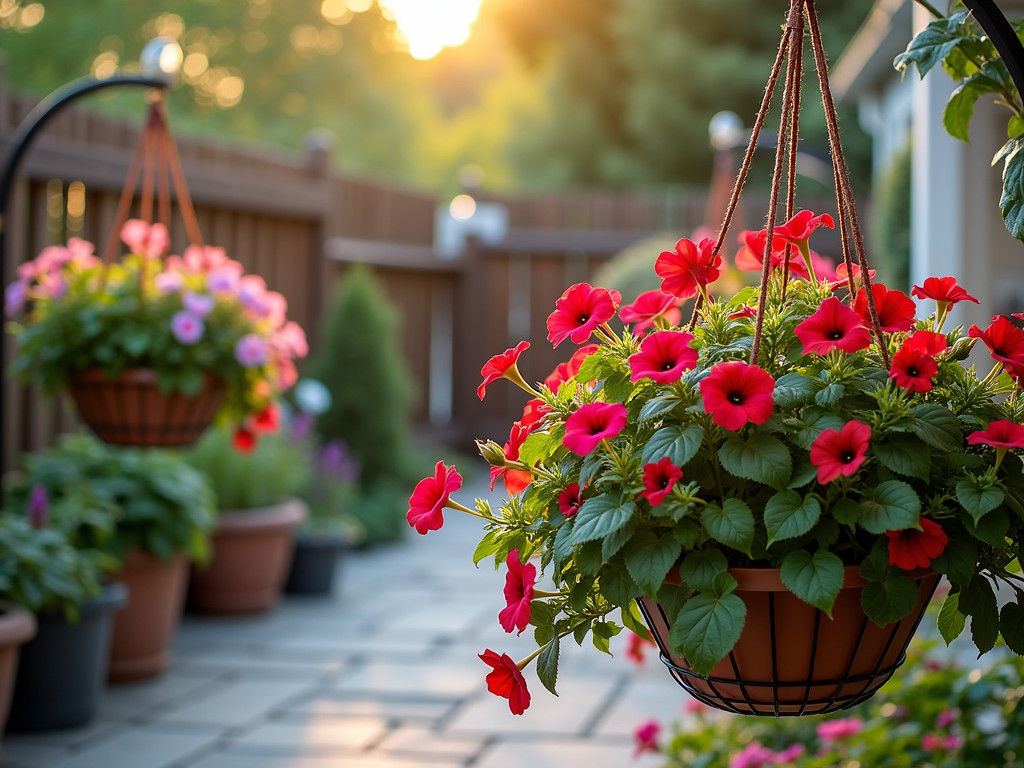
There’s something magical about stepping onto a patio filled with vibrant life. As someone who has traveled across continents studying how different cultures create their outdoor sanctuaries, I’ve discovered that the right combination of patio plants can transform even the smallest space into a breathtaking retreat. Whether you’re working with a sun-drenched balcony or a shaded corner, these 19 carefully chosen plants will help you create your own slice of paradise.
The first time I encountered trailing petunias cascading down from stone balconies in South America, their native homeland, I was mesmerized by their endless waves of color. These versatile bloomers have since become a staple in patio gardens worldwide, and for good reason. Their abundant flowers create stunning visual impact whether draped from hanging baskets or spilling over container edges.
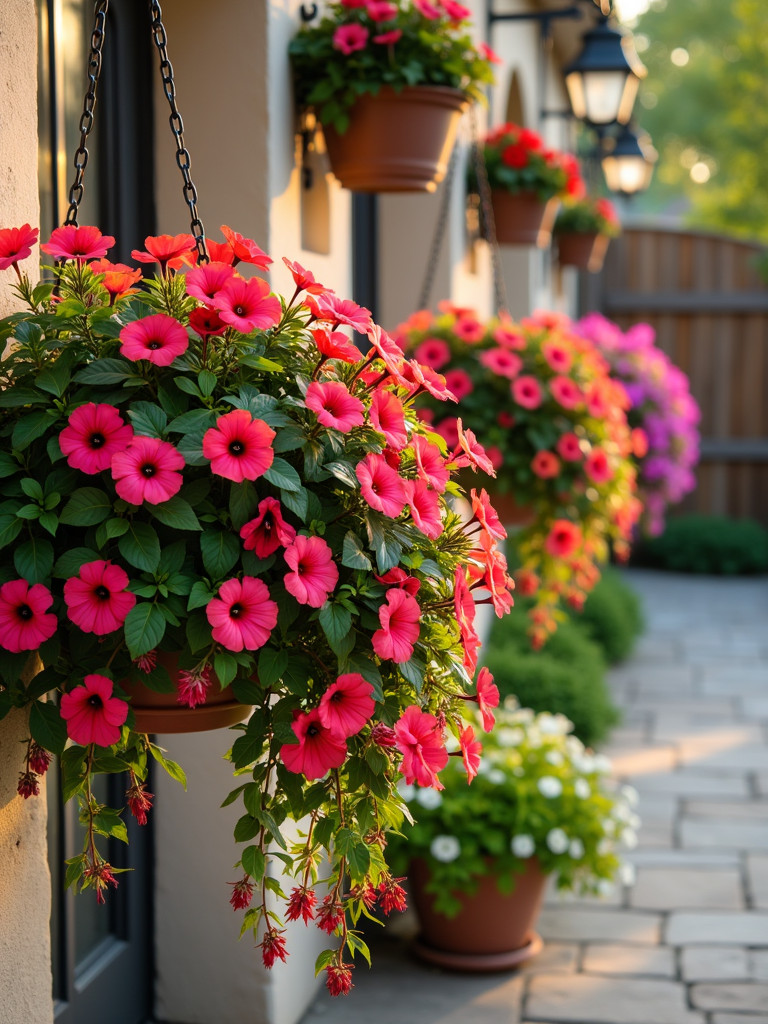
To keep these beauties blooming their best, regular deadheading is essential – think of it as a gentle conversation with your plant, encouraging new growth with each pinch. Water them when the top inch of soil feels dry, and feed them with a balanced liquid fertilizer every two weeks during the growing season. One of the most rewarding aspects of growing trailing petunias is their ability to respond dramatically to care – the more attention you give them, the more they’ll reward you with waves of vibrant blooms.
In my travels through arid regions, I’ve been continually amazed by how succulents have adapted to thrive in the most challenging conditions. These resilient patio plants bring that same hardy beauty to your space, creating living sculptures that evolve throughout the seasons. Their water-storing leaves and stems make them perfect for busy gardeners or those who tend to be forgetful with watering schedules.

The key to successful succulent containers lies in the foundation – well-draining soil is absolutely crucial. I recommend creating your own mix by combining regular potting soil with coarse sand and perlite. When it comes to watering, less is more; wait until the soil is completely dry before watering again. One of my favorite ways to display succulents is to create a mini garden in a shallow bowl, combining different shapes, sizes, and colors for a dynamic display that changes as the plants grow and spread.
During my visits to small Italian courtyards, I’ve often found myself enchanted by the sight and scent of dwarf citrus trees, their glossy leaves catching the sunlight and their fragrant blossoms perfuming the air. These compact fruit-bearing patio plants bring a touch of Mediterranean charm to any space, while offering the incredible reward of home-grown citrus fruits.
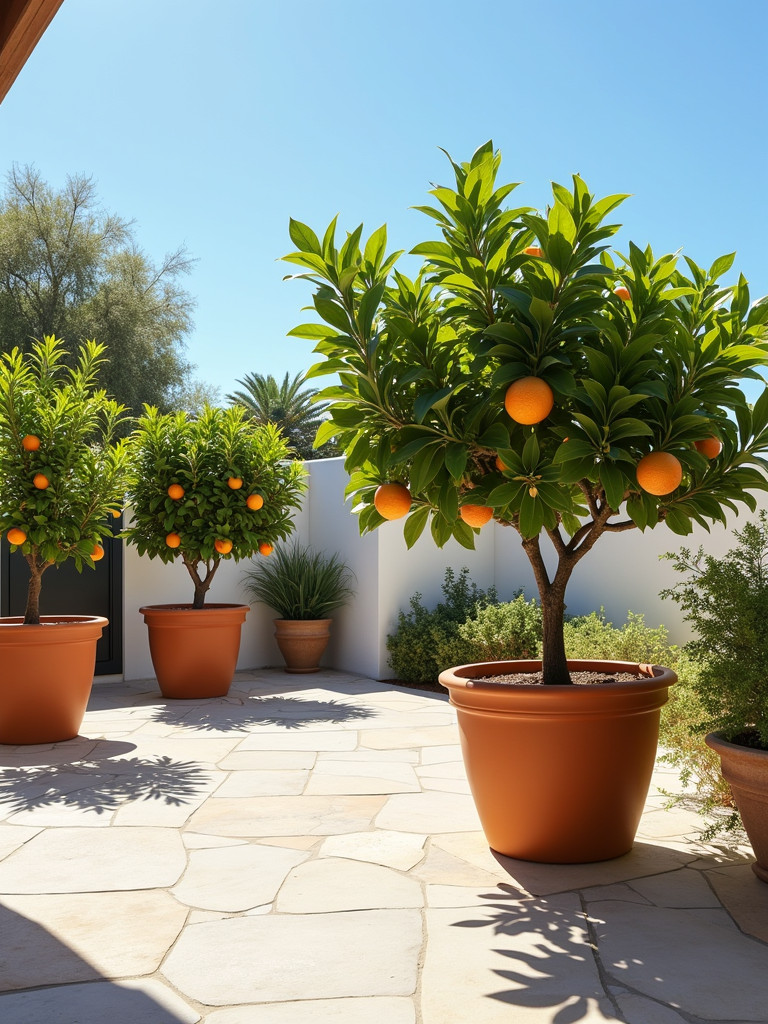
Success with dwarf citrus begins with understanding their needs. These sun-lovers require at least 6-8 hours of direct sunlight daily to thrive and produce fruit. I’ve found that a balanced, slow-release citrus fertilizer applied every 6-8 weeks during the growing season keeps them healthy and productive. For those in colder climates, the beauty of container-grown citrus is their portability – simply move them indoors when temperatures drop below 40°F (4°C).
In the sun-drenched fields of Provence, lavender stretches as far as the eye can see, but you don’t need acres of land to enjoy this beloved herb. Container-grown lavender brings the same calming presence to your patio, attracting pollinators while creating a sensory delight with its silvery foliage and signature fragrance.
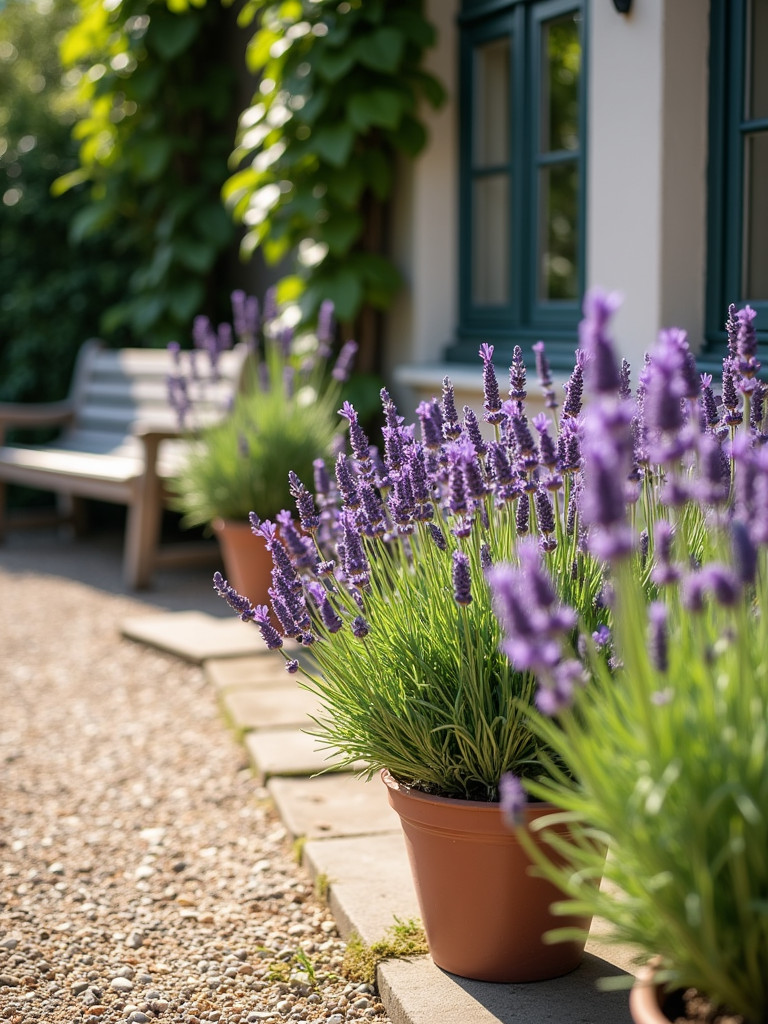
The secret to thriving lavender lies in replicating its native growing conditions. Well-draining soil is absolutely crucial – I recommend mixing regular potting soil with coarse sand or gravel to achieve the perfect balance. Pruning is another key aspect of lavender care; a light trim after the first bloom can encourage a second flush of flowers, while maintaining the plant’s compact shape. One of my favorite ways to use patio-grown lavender is to harvest the stems just as the buds begin to open, creating fragrant bouquets that bring the essence of summer indoors.
My grandmother’s patio in Mumbai always featured clusters of geraniums in clay pots, their bright blooms adding cheerful splashes of color throughout the seasons. These hardy patio plants have found their way into gardens across the globe, and for good reason – they’re incredibly versatile and rewarding to grow, offering continuous blooms with minimal fuss.
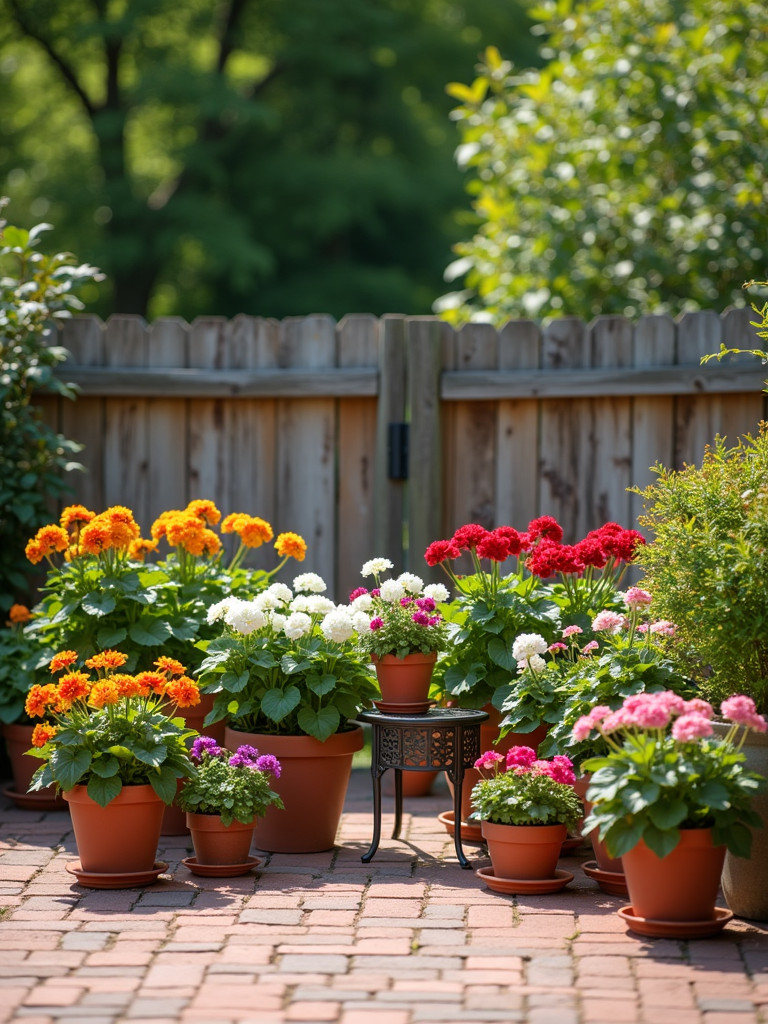
The key to abundant geranium blooms lies in regular deadheading and proper feeding. I recommend fertilizing every two weeks during the growing season with a balanced liquid fertilizer. One of the most fascinating aspects of geraniums is their ability to overwinter – in colder climates, you can bring them indoors and keep them as houseplants, or store them dormant in a cool, dark place. When spring returns, these resilient plants will burst back to life with renewed vigor.
During my explorations of English cottage gardens, I discovered the enchanting world of fuchsias, their delicate blooms dangling like exotic earrings in dappled shade. These elegant patio plants bring a touch of woodland magic to any space, particularly in hanging baskets where their graceful flowers can be appreciated at eye level.
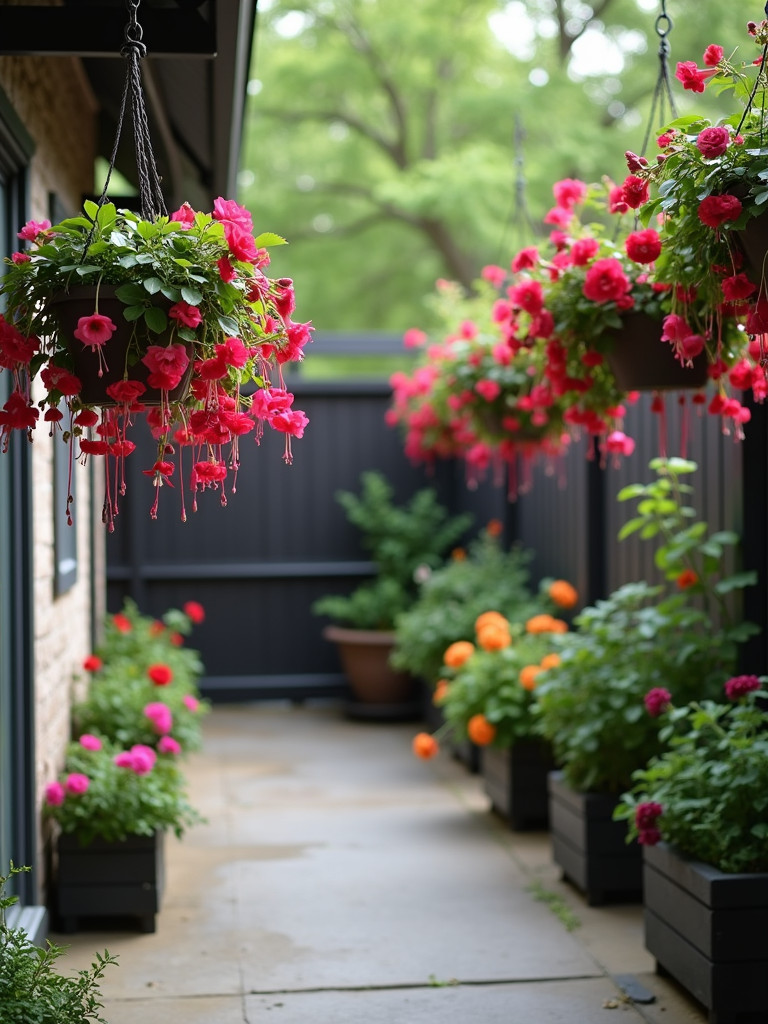
The secret to fuchsia success lies in consistent moisture and protection from harsh afternoon sun. These plants thrive in humid conditions, so regular misting helps recreate their natural habitat. What many don’t realize is that fuchsias are actually hummingbird magnets – in their native South American habitat, these tiny birds are their primary pollinators. Position your fuchsias where you can enjoy both the beautiful blooms and the wildlife they attract.
During my visits to traditional Southern homes in the United States, I’ve been captivated by the sight of Boston ferns swaying gently on wraparound porches. These classic patio plants have graced outdoor spaces for generations, and their enduring popularity is a testament to both their beauty and adaptability. As one of the oldest known houseplants, they bring a touch of Victorian elegance to any setting.

The secret to lush, full Boston ferns lies in maintaining consistent humidity and proper light conditions. I’ve found that regular misting, especially during dry spells, keeps their fronds bright and perky. Position them away from direct sunlight – these plants naturally grow in forest understories, where they receive filtered light through the canopy above. One of the lesser-known benefits of Boston ferns is their air-purifying abilities, making them not just beautiful but beneficial additions to your outdoor living space.
My fascination with hydrangeas began in the misty gardens of Japan, where these spectacular shrubs have been cultivated for centuries. What makes these patio plants particularly intriguing is their chameleon-like ability to change bloom colors based on soil chemistry – a characteristic that has captivated gardeners worldwide. In containers, this trait becomes even more exciting as you can easily control the growing conditions.
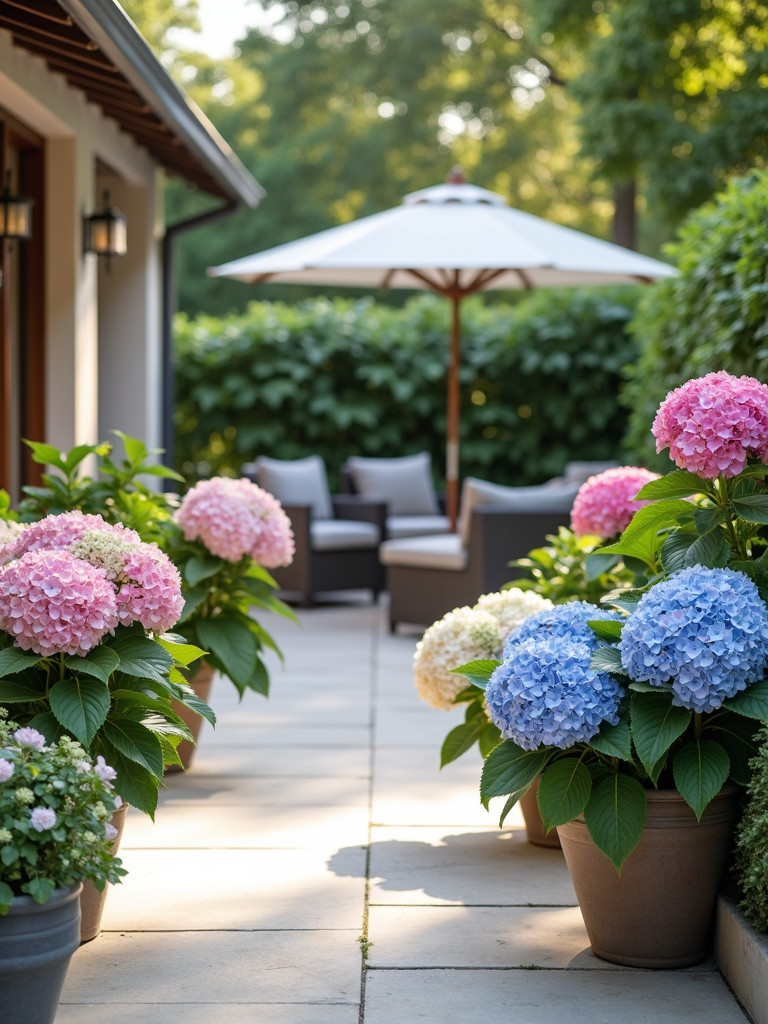
Success with container-grown hydrangeas starts with proper sizing – choose a large pot that allows for root growth and water retention. The key to keeping them happy is consistent moisture; these plants have a low tolerance for drought. I’ve found that adding a layer of mulch helps retain moisture and regulate soil temperature. Perhaps the most fascinating aspect of hydrangeas is how you can influence their flower color – adding aluminum sulfate to acidic soil promotes blue blooms, while lime encourages pink flowers.
Throughout my travels, I’ve noticed how different cultures incorporate herbs into their daily lives, from the aromatic basil in Italian courtyards to the prolific mint in Moroccan patios. Creating a container herb garden brings not only visual interest to your patio but also adds fantastic flavor to your culinary adventures. The combination of basil, mint, and rosemary offers a perfect balance of flavors and textures.

The secret to a thriving herb container garden lies in proper placement and regular harvesting. Most herbs prefer full sun, though some, like mint, can tolerate partial shade. I recommend harvesting herbs regularly – not only does this provide you with fresh ingredients, but it also encourages bushier growth. One of my favorite aspects of growing herbs is how they bring the garden to life with visiting pollinators, adding movement and sound to your patio sanctuary.
In the tropical regions of South America, peace lilies grow naturally in the dappled light beneath forest canopies. This elegant patio plant has made its way into gardens worldwide, cherished for its glossy leaves and pristine white flowers. On a patio, peace lilies bring a sense of tranquility and sophisticated simplicity to shaded areas.
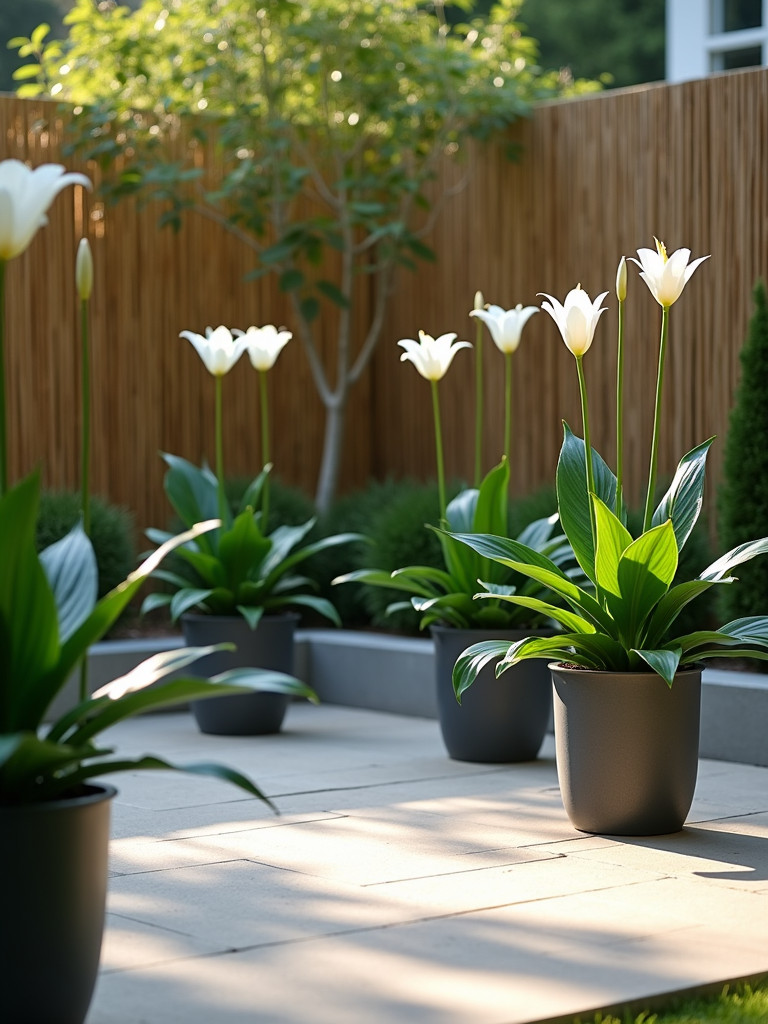
The beauty of peace lilies lies in their adaptability and clear communication – they’ll tell you exactly when they need water by drooping their leaves slightly. Recovery is quick once watered, making them forgiving of occasional neglect. Beyond their aesthetic appeal, peace lilies are powerful air purifiers, capable of removing various household toxins. I particularly love how their white blooms seem to glow in evening light, creating natural focal points in shaded corners.
During my explorations of Southeast Asian gardens, I’ve been repeatedly amazed by the artistry of caladium leaves – their patterns and colors rival the most beautiful textiles I’ve encountered in my travels. Often called “Angel Wings” or “Elephant Ears,” these stunning foliage plants bring an element of tropical luxury to shaded patio spaces, creating visual interest without relying on flowers.
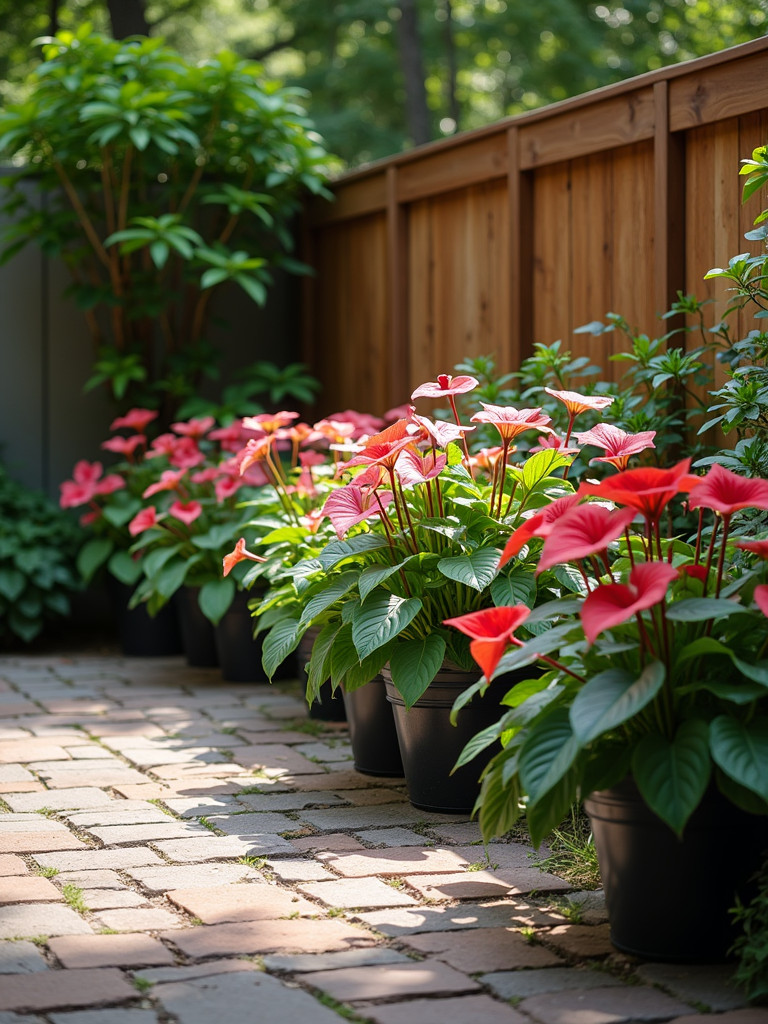
The secret to vibrant caladium leaves lies in understanding their natural habitat. These understory plants thrive in warm, humid conditions with filtered light. I’ve found that maintaining consistently moist (but not waterlogged) soil brings out the best in their coloration. One of the most fascinating aspects of caladiums is how their leaves seem to glow when backlit by morning or evening sun – position them where this natural light show can be appreciated.
My first encounter with a Bird of Paradise plant in a South African garden left me spellbound – its dramatic flowers truly do resemble exotic birds in mid-flight. These architectural patio plants bring instant tropical drama to any space, serving as stunning focal points with their large, paddle-shaped leaves and distinctive blooms.
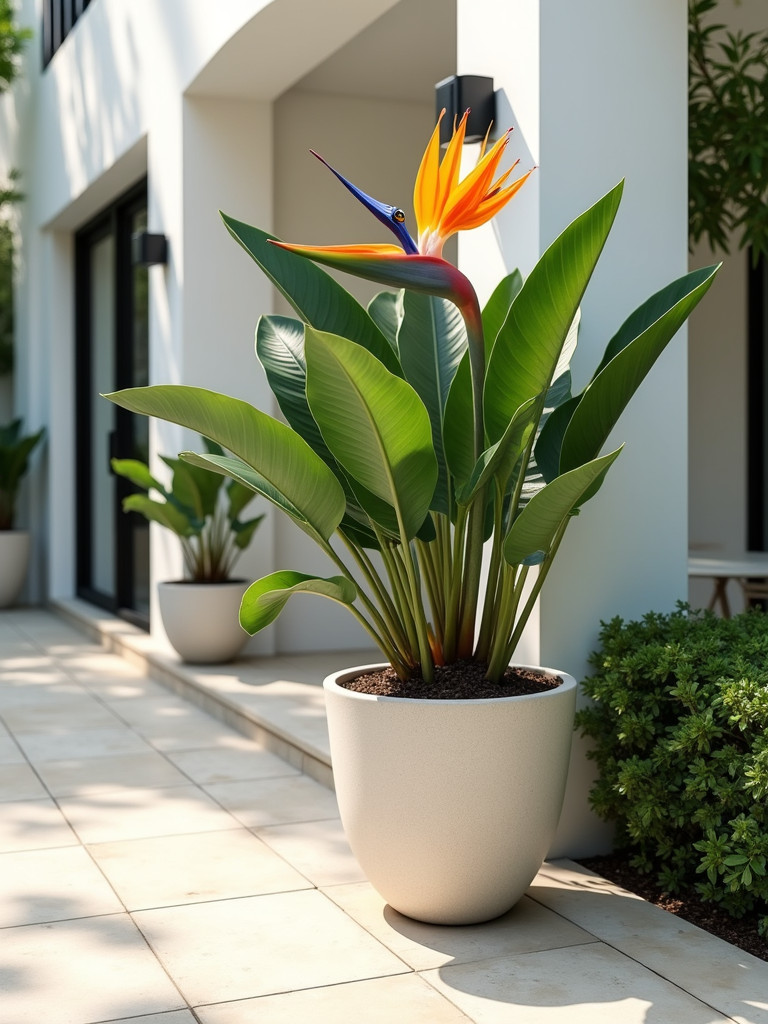
Patience is key with Bird of Paradise plants, as they can take several years to produce their first flowers. However, the wait is well worth it. In containers, they need plenty of room for their extensive root system – I recommend a large, sturdy pot with excellent drainage. The reward for proper care isn’t just in their spectacular blooms; the large, banana-like leaves create a year-round tropical atmosphere that transforms any patio into an exotic retreat.
In the gardens of Brazil, I’ve watched mandevilla vines transform simple structures into flowering masterpieces. These vigorous climbers, with their glossy leaves and trumpet-shaped blooms, bring vertical interest and tropical flair to any patio setting. Their ability to flower continuously throughout the warm season makes them particularly valuable for long-lasting color.
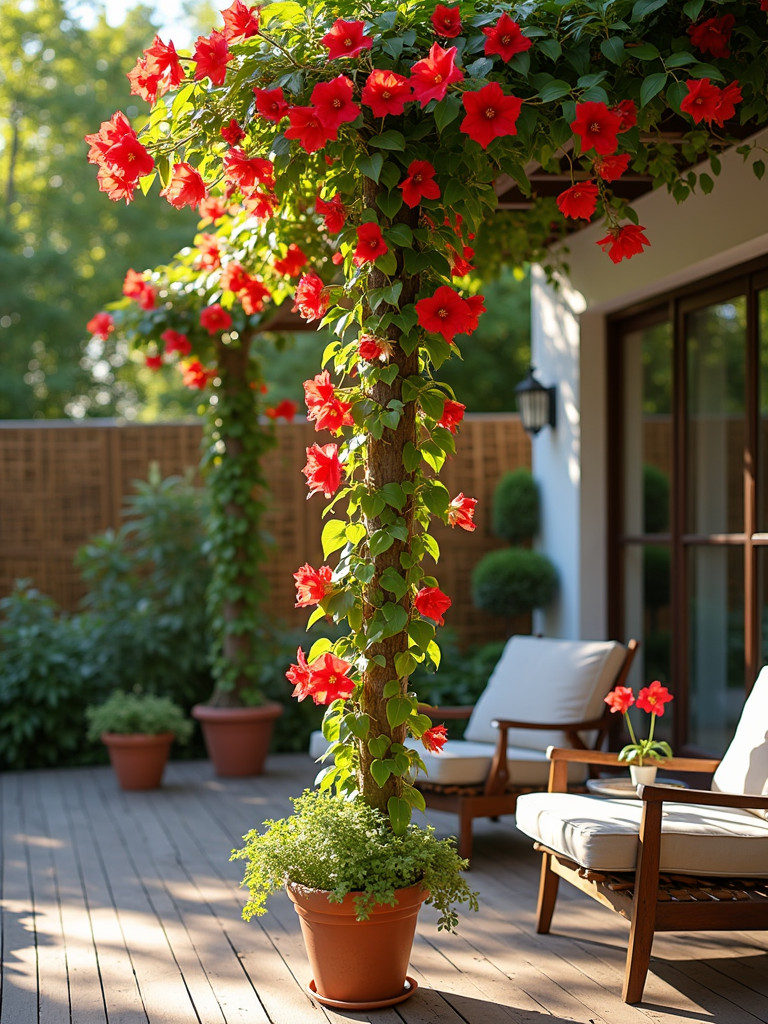
Success with mandevilla starts with proper support – a trellis or decorative obelisk provides the perfect framework for their climbing habit. Regular fertilization during the growing season encourages abundant blooming, while proper watering keeps the vine lush and healthy. What I particularly love about mandevilla is its versatility – it can be trained up posts, along railings, or even in hanging baskets where its trailing habit creates cascades of color.
During my visits to shade gardens across India, I’ve been consistently amazed by the creative use of coleus, whose leaves come in an array of patterns and colors that would make any artist envious. These versatile patio plants prove that you don’t need flowers to create a vibrant display – their foliage alone provides endless combinations of colors and textures.
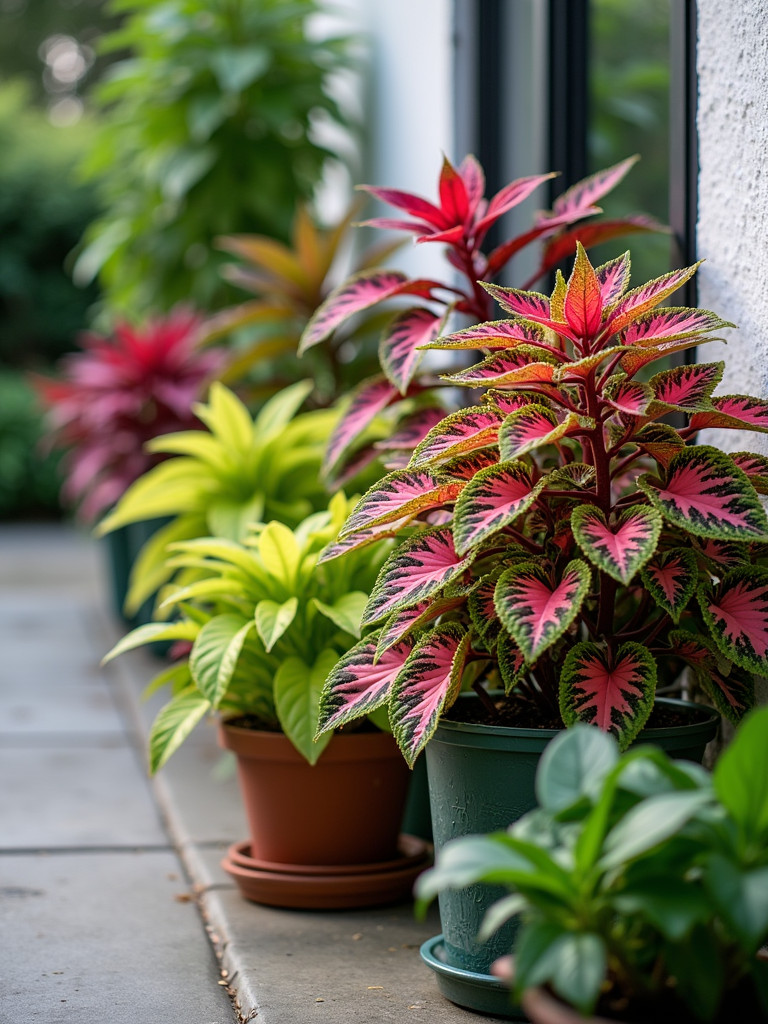
The secret to keeping coleus looking their best lies in regular pinching and proper light exposure. While they can tolerate some sun, too much direct light can fade their vivid colors. I’ve found that pinching off the growing tips encourages bushier growth and prevents the plants from becoming leggy. One of the most rewarding aspects of growing coleus is how quickly they respond to care – regular attention results in fuller, more colorful plants within weeks.
Throughout my travels in tropical Asia, I’ve encountered begonias adorning shaded patios like living jewels, their diverse forms ranging from delicate angel-wing varieties to bold, rex begonias with their metallic-sheened leaves. These adaptable patio plants bring both foliage interest and charming flowers to shaded spaces, making them invaluable for creating multi-layered displays.
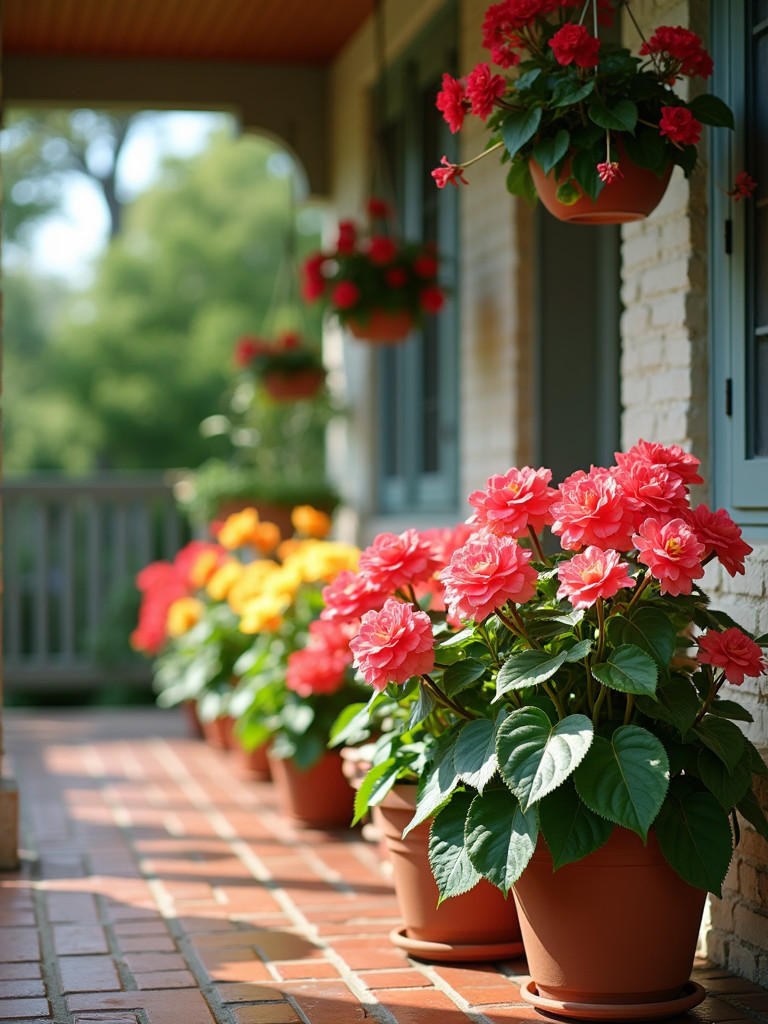
The key to begonia success lies in finding the perfect balance of moisture and light. While they love humidity, they’re surprisingly prone to root rot if overwatered. I recommend allowing the top inch of soil to dry between waterings and providing protection from harsh afternoon sun. What fascinates me most about begonias is their incredible diversity – each variety brings its own unique character to the patio, from cascading bloomers perfect for hanging baskets to upright forms that create stunning container centerpieces.
My appreciation for Japanese maples deepened during my studies of traditional Japanese gardens, where these elegant trees are often featured as focal points, their delicate leaves creating ever-changing displays of color and texture throughout the seasons. In containers, they bring this same refined beauty to patio spaces, creating living sculptures that evolve with the passing months.
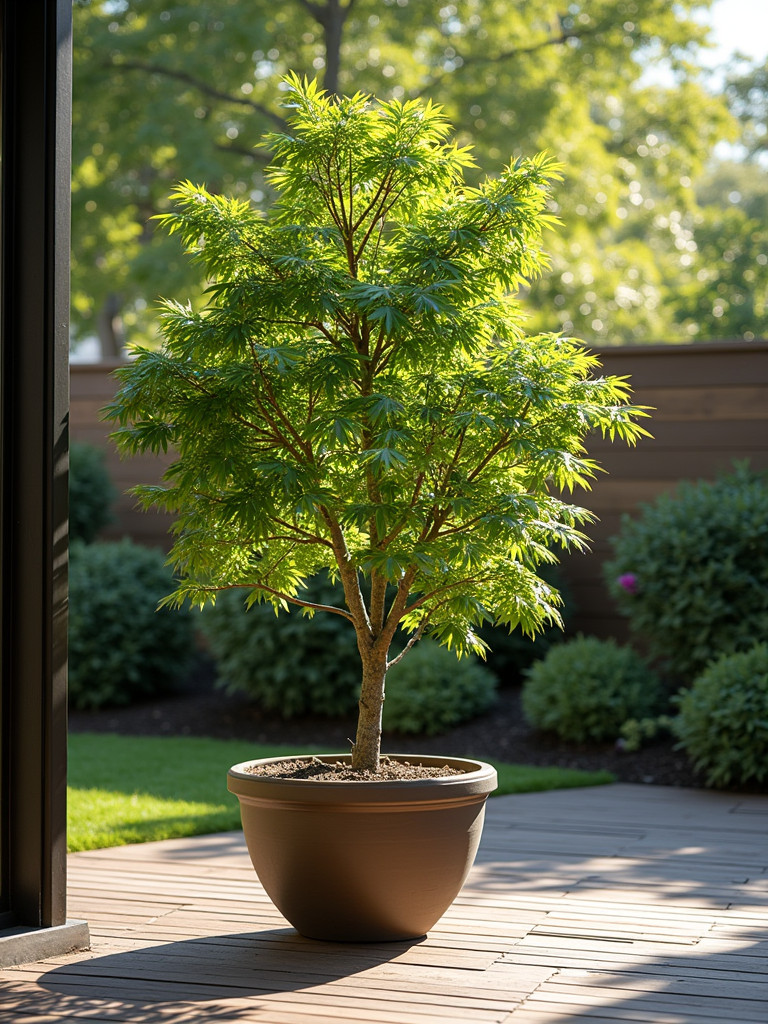
Growing Japanese maples in containers requires attention to detail, but the results are worth every effort. The key lies in protecting these sensitive trees from environmental stress – particularly harsh afternoon sun and drying winds. I’ve found that slightly acidic, well-draining soil and consistent moisture are crucial for healthy growth. One of the most rewarding aspects of container-grown Japanese maples is their slow, graceful development over the years, each season bringing new appreciation for their changing colors and forms.
During my time in Hawaii, I was captivated by how hibiscus flowers were woven into daily life, from garden borders to ceremonial leis. These show-stopping patio plants bring the same tropical drama to intimate spaces, their dinner-plate-sized blooms creating bold focal points that draw both human admirers and hummingbirds alike.
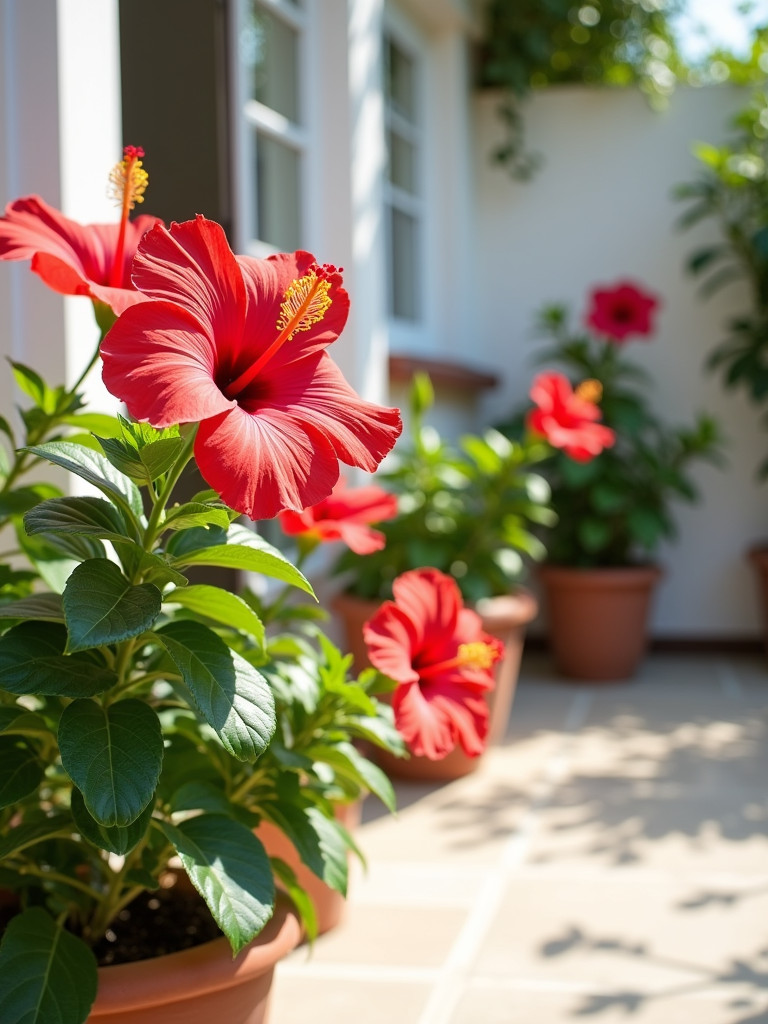
The secret to abundant hibiscus blooms lies in proper feeding and pruning. These heavy feeders benefit from regular applications of balanced fertilizer during the growing season, while selective pruning helps maintain shape and encourages new flower production. What I find most fascinating about hibiscus is how each bloom, though lasting only a day, opens with such spectacular beauty that it makes every morning a cause for celebration.
In my exploration of Japanese temple gardens, I’ve observed how hostas are revered for their ability to bring light and texture to shaded spaces. These versatile patio plants, with their wide range of leaf colors, sizes, and patterns, create living tapestries that become more impressive with each passing year.
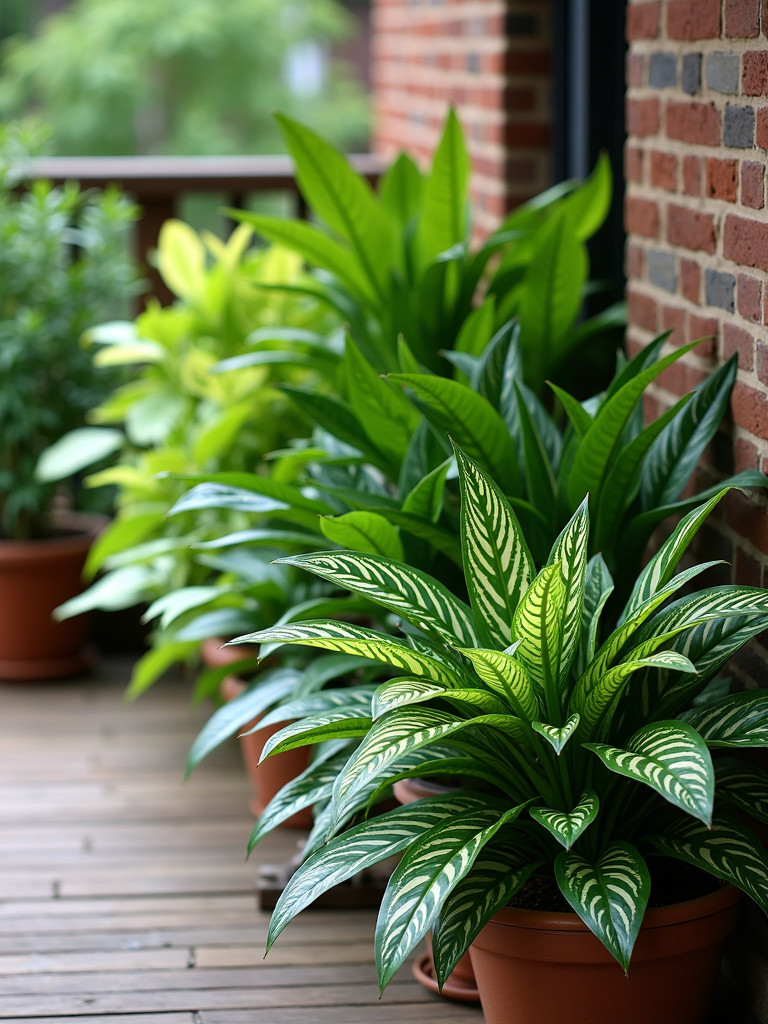
Success with container-grown hostas begins with proper pot selection – choose containers with excellent drainage and enough room for their expanding root systems. While slugs can be a challenge, I’ve found that elevating containers and using copper tape around pot rims provides effective protection. What I particularly love about hostas is their ability to combine with other shade-lovers, creating layered displays that bring depth and interest to even the darkest patio corners.
In my visits to modern urban gardens across Asia, I’ve noticed the rising popularity of the ZZ plant, and it’s easy to understand why. This architectural beauty, with its glossy, dark green leaves arranged in perfect symmetry, brings a touch of sophisticated minimalism to any patio space. What makes it truly remarkable is its ability to thrive in conditions that would challenge most other plants.

The ZZ plant’s resilience comes from its unique root system, which stores water like a natural reservoir. This adaptation means you can relax about watering schedules – in fact, overwatering is the most common mistake I see with these plants. Let the soil dry out completely between waterings, and place it in a shaded corner where its sculptural form can create a striking focal point. As an air-purifying plant, it’s not just beautiful but functional, making it a perfect choice for urban patios where air quality might be a concern.
As we conclude our journey through these transformative patio plants, remember that creating your perfect outdoor space is a personal expression of your style and needs. Whether you choose the dramatic blooms of trailing petunias or the elegant simplicity of a ZZ plant, each choice adds its own character to your patio story. The key is to start with one or two plants that speak to you, and gradually build your collection as you discover the joy of nurturing your own outdoor sanctuary.